Tuesday, 21 July 2015: Busy day
Written 21 July 2015
This morning, Jan and I are signed up for the Moraine Park Nature Walk (9–12 a.m.), and David and I have the 1:04 p.m. tee time at the 18-hole golf course, so I'll pack a sandwich, and as soon as we get back to the Y at the end of the walk, Jan will run me down to the golf course, where David will already be warming up. I'll scarf my sandwich along the way. As soon as David and I finish playing golf, we'll come back up to the cabin for a quick shower and change before we all head off to the Dunraven, a nearby restaurant that Jan loves, for dinner. It's Italian, and I think the ziti and lobster-claw baked in cream sauce looks great. (I love being able to read menus in advance, on line.)
At least that's the plan, though thunder showers are predicted. The percentages have gone down since I checked last night, so maybe we'll get everything in anyway.
I had leftover tetrazini and chicken gizzards for breakfast this morning, and a couple of oreos. (The chicken I bought had no heart or liver, but it had five gizzards.)
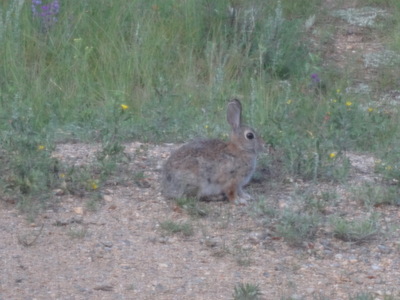
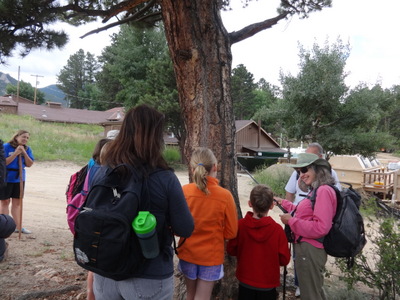 The animal of the day spotted out the window first thing was this bunny, larger than the one we'd seen before, sitting by the parked cars, placidly munching on scrubby little bushes that must have been covered with dust. At least he's getting his minerals.
The animal of the day spotted out the window first thing was this bunny, larger than the one we'd seen before, sitting by the parked cars, placidly munching on scrubby little bushes that must have been covered with dust. At least he's getting his minerals.
Later in the day
The Moraine Park nature walk was great! Our guide, Susan, knew all the wildflowers and was delighted that anyone wanted to stop and look at them—apparently most people just want to spot animals. Susan is shown in the photo to the right of the bunny, pointing out bear-claw marks on a tree at the beginning of the walk. She had us all sniff the scratched places—a vanilla odor is diagnostic of the ponderosa pine.
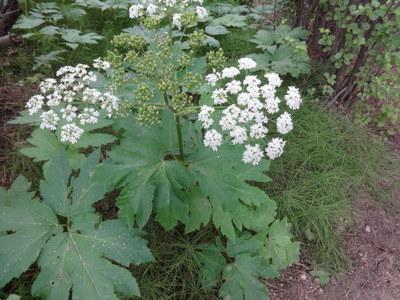
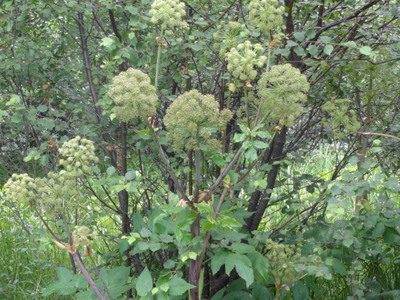 Again, I'll start showing flower photos (I took a bazillion, but I present only the better shots here). Here are have cow parsley (or cow parsnip?) on the left and giant angelica on the right. The first has flat umbels and the second globular ones.
Again, I'll start showing flower photos (I took a bazillion, but I present only the better shots here). Here are have cow parsley (or cow parsnip?) on the left and giant angelica on the right. The first has flat umbels and the second globular ones.
We did see some animals on the walk, though I didn't get photos: white-breasted nuthatch, a woodpecker that Susan said was a downy but that clearly wasn't (I'm guessing acorn), a robin, some crows, another Nuttall's cottontail, a chickaree (aka red or pine) squirrel, and a mule deer doe. Jan and some others saw a black squirrel, but I was taking a flower photo at the time and missed it.
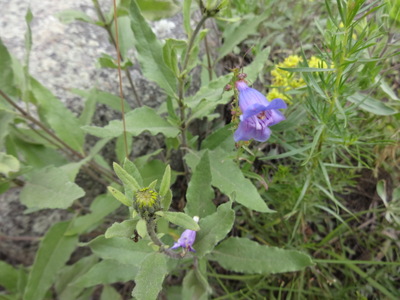
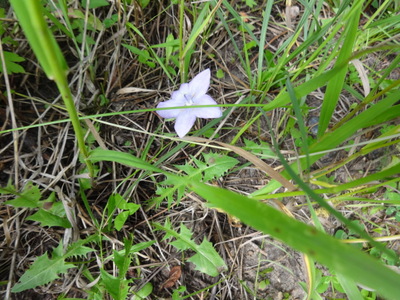 Here, on the left is what I'm pretty sure is the beardless penstemon, so the one I showed above must be the one-sided. At the right is a little blue flower than Susan couldn't come up with the name of, about the size of a penny and very low to the ground. She hypothesized blue-eyed Mary, but wasn't very unsure, and I don't think it was. I'm guessing flax (not really flax but what they call flax in the Rockies), but I'm not sure either.
Here, on the left is what I'm pretty sure is the beardless penstemon, so the one I showed above must be the one-sided. At the right is a little blue flower than Susan couldn't come up with the name of, about the size of a penny and very low to the ground. She hypothesized blue-eyed Mary, but wasn't very unsure, and I don't think it was. I'm guessing flax (not really flax but what they call flax in the Rockies), but I'm not sure either.
The chickaree squirrel was very tame. He was perched on a tree root right next to the trail, and when we stopped to look at him, he came down and wandered right through the group! He walked over someone's foot, then started up the back of someone's calf (she was wearing streaky gray leggings that looked a little like tree bark) before thinking better of it and continuing his way.

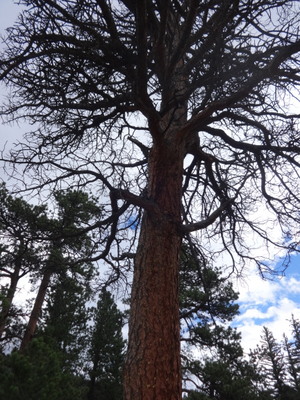
Here, on the left, is a close up of the bark of the dead ponderosa pine shown at the right. You can see the little bore holes and oozing sap characteristic of the pine bark beetle. The beetles bore into the vascular tissue of the tree, interfering with transport of water and nutrients upward and products of photosynthesis downward. They also carry blue-stain fungus, which has much the same effect.
Susan explained that when the population of beetles in a tree gets high, the beetles produce a pheromone warning other beetles off, to prevent overcrowding. You can now apparently buy that pheromone as a product called "Beetle Block" to apply to your as-yet healthy trees to keep beetles away.

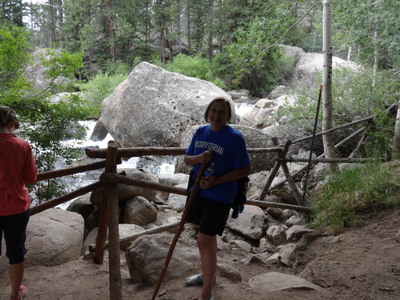
In the course of the hike (well, stroll), we crossed into the National Park as we passed the sign at the left, which listed the park's rules. We also crossed several watercourses, including Glacier Creek (a tributary of the Big Thompson) and the Big Thompson River, shown here with Jan in the foreground (yes, she is a Presbyterian, but her shirt says that because she's head of the lower division of Presbyterian School is Houston). This was where we stopped for a "water break" under the shade of an overpass (Bear Lake Rd., on its way into the national park).
At each crossing, a prominent red sign shouted "Stay back from the water! People have died here!" and continued with explanation that the rocks are very, very slippery; the water is travelling very fast; and water that cold can quickly incapacitate even strong swimmers. In the smaller streams, people in waders were fishing for trout.
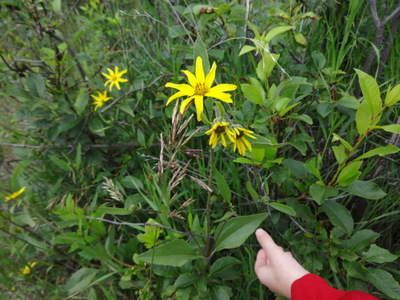
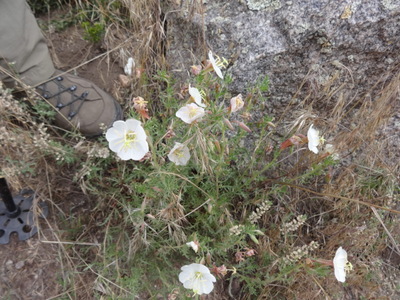 At the left here is the low or bush sunflower, recognizable by its extremely rough, sandpapery leaves. At the right is a clump of cut-leaf primrose, a very pale Oenothera.
At the left here is the low or bush sunflower, recognizable by its extremely rough, sandpapery leaves. At the right is a clump of cut-leaf primrose, a very pale Oenothera.
The destination at the far end of the hike was Moraine Park, a wide marshy meadow between the lateral moraines of a long-gone glacier. We saw no wildlife there (except the ever-present swallows), but Susan said she'd seen moose there recently and that elk were quite common. A good-sized section of the meadow was fenced off to keep the larger wildlife from overgrazing and overbrowsing the stream banks. Deer are browsers, we were told, and elk are grazers.

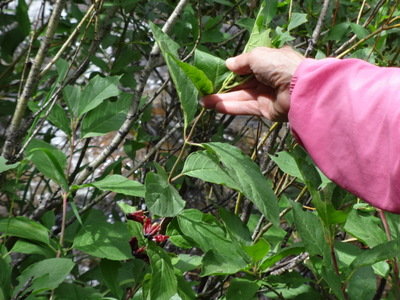 On the left here is a stalk of pinedrops, a root parasite of trees. It's in the Ericaceae, the blueberry family, but like most parasitic plants, it doesn't bother with photosynthesis and has reduced itself to the essentials (stem, flowers, fruiting bodies) and doesn't much look like it. We also saw a specimen of the other tree-root parasite in the area, an orchid called spotted coral root, but it was old, and the flowers were withered and brown.
On the left here is a stalk of pinedrops, a root parasite of trees. It's in the Ericaceae, the blueberry family, but like most parasitic plants, it doesn't bother with photosynthesis and has reduced itself to the essentials (stem, flowers, fruiting bodies) and doesn't much look like it. We also saw a specimen of the other tree-root parasite in the area, an orchid called spotted coral root, but it was old, and the flowers were withered and brown.
On the right is a twinberry shrub (a congener of our common honeysuckle), with Susan's hand holding the leaves aside so that we could see the red structures. The flowers are actually yellow; the red you see here is the walls of the seed pod, which peel backwards to reveal the twin black berries, which have already fallen off.
Here's the full list of flowers we saw on the walk with Susan:
- Yellow cinqfoil (picture on a later page; very common)
- Melilotus of some kind (tiny yellow bean-family flowers)
- Yarrow
- Musk thistle (huge and purple, a nonnative pest)
- Wax currant (very common)
- Nodding onion (a cluster of small nodding red-purple flowers)
- Puccoon (little yellow tubular flowers)
- Antelope bitterbrush (aka "deer candy")
- Mariposa lily (aka sago lily; did I mention that "mariposa" means butterfly?)
- Ponderosa pine (the one that smells like vanilla)
- Harebells (probably mountain harebells, nodding blue flowers)
- Aspen
- Alder
- Colorado locoweed
- Stonecrop, a yellowflowered sedum (edible, high in vitamin C, supposedly good in salads)
- Pinedrops (the root parasite shown above)
- Bedstraw (was used by pioneers to stuff mattresses with)
- Indian paintbrush
- Sulfur-flower (yarrowlike, basal rosette, no leaves on stalk, yellow)
- Little pinkish bindweeds (like miniature morning-glories)
- Purple vetch or some sort
- Beebalm (pink, aka horsemint)
- That blue flower that isn't blue-eyed Mary but might be "flax"
- Gumweed (a low yellow composite)
- Forget-me-nots
- Lavender "asters" that Susan assures me are atually daisies because the asters don't bloom until fall
- Little white marguerite-like things, like miniature ox-eye daisies
- Beardless penstemon, blue
- Rocky mountain juniper (a tree)
- Common juniper (a low shrub)
- Low or bush sunflower (the one with sandpaper leaves)
- Choke cherries (in this environment, stunted little shurbs about two feet high)
- Cutleaf primrose, an Oenothera
- Indian blanket-flower ( a large composite with a red center)
- Giant angelica (globular umbels rather than flat ones like cow parsley)
- Coneflower (another yellow composite with a large bulbous center)
- Prunella (Susan didn't know this one, but it looked like Prunella to me)
- Wild strawberry (no berries)
- Dogbane (Susan said the flowers looked like dog's ears; I don't think she knows what "bane" means)
- A golden aster, possibly Heterotheca villosa
- Goldenrod (about three inches tall)
- Golden banner (a good-sized legume, in fruit rather than flower)
- A very low shrub with tiny dense white flowers, looked like Rhamnaceae leaves to me but not stiff (Susan knew it but couldn't remember the name)
- Fringed sage (very common, the low grayish shrub in the background of many of my photos)
- Blackeyed Susans (the familiar large yellow composite with dark centers)
- Serviceberry (Amelanchier, in green fruit)
- Willow (with galls on the leaves)
- Twin-berry shrub (held in guide's hand)
- Raspberries (in green fruit)
- Spotted coral root (the root-parasitic orchid; the flowers were dead)
- Rocky mountain currant or gooseberry (a spiny shrub)
- Horsetails
- Rumex (I think)
Susan got us back to the Y's hiking center on the stroke of noon, and after a quick stop for Jan to make another massage appointment, we headed downtown (while I munched my chicken sandwich and cookies), where Jan dropped me at the 18-hole golf course, where David was already on the driving range. We finished warming up and managed to get in five and a half holes before the lightning got too close and we ran for the clubhouse. Hard to tell whether the rain was going to pass over, but after consulting the guys in the pro shop and their weather website, we gave up, collected a rain check, and headed back to Bear's Den.
On the course, a guy in waders was up over his waist in one of the ponds, raking and hand-removing a heavy mat of algae. (He was there every time we were that week, sometimes with help from a second wader, and that the end of the week they hadn't cleared half the pond. On the scummy pond was a mother duck with half-grown babies. They followed the wader around, clearly munching on invertebrates and whatnot that were fleeing the clumps of slime.
Swallows were zooming around, skimming over the greens an inch or two from the ground, even among our feet as we were putting! Some were barn swallows (Hirundo rustica). The others could have been tree swallows (Tachycineta bicolor) or violet-green swallows (Tachycineta thalassina). There might even have been three kinds, but I think those that were dark above and white below, but with without white on the rump, were probably male and female of one species.
Jan finished the grocery shopping, then by the time we got back to the cabin, was off having her hip massaged again, and the rest of us were driven in off the porch by the cold wind. David took Zorro out for another walk, specifying to the dog before departure, "We're not going cross country this time; stick to the road!"
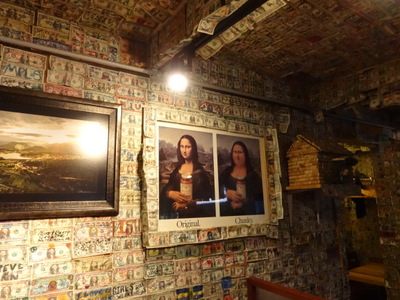
 For dinner, we went to the Dunraven, which is famous for its decor as well as its food. The front room is entirely papered in dollar bills signed by diners, and throughout it displays a large collection of variations on the Monda Lisa. At the left here is a segment of the dollar-covered wall and a two-panel protrayal of the Mona Lisa holding a jar of spaghetti sauce; the two panels are labeled "regular" and "chunky."
For dinner, we went to the Dunraven, which is famous for its decor as well as its food. The front room is entirely papered in dollar bills signed by diners, and throughout it displays a large collection of variations on the Monda Lisa. At the left here is a segment of the dollar-covered wall and a two-panel protrayal of the Mona Lisa holding a jar of spaghetti sauce; the two panels are labeled "regular" and "chunky."
At the right is the dish of seasoned oil and vinegar we were served with our bread sticks—the particulates are mostly crispy garlic bits.
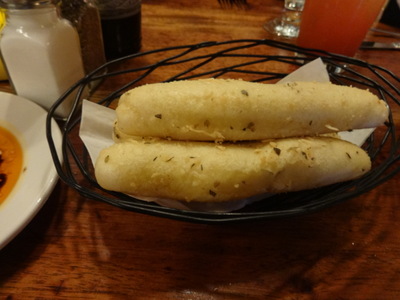
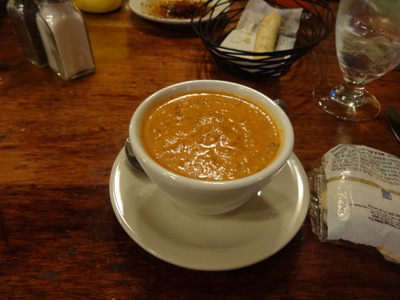 At the left here is the basket of soft breadsticks, coated with butter, parmesan, and garlic, to be torn up and dipped into the dish of oil and vinegar.
At the left here is the basket of soft breadsticks, coated with butter, parmesan, and garlic, to be torn up and dipped into the dish of oil and vinegar.
At the right is my soup starter (everyone else chose the house salad, with various dressings), billed as creamy pepper and sausage. The sausage was roughly puréed into the group. Not bad.

 At the left here is the house salad, with Italian dressing. All the other usual choices were also available—ranch, blue cheese, etc.
At the left here is the house salad, with Italian dressing. All the other usual choices were also available—ranch, blue cheese, etc.
On Jan's recommendation, David ordered the spaghetti and meatballs, showed here at the right. I tried the pasta and marinara, which were quite good. David said the meatballs were also delicious, but the serving was so large he couldn't come close to finishing it.
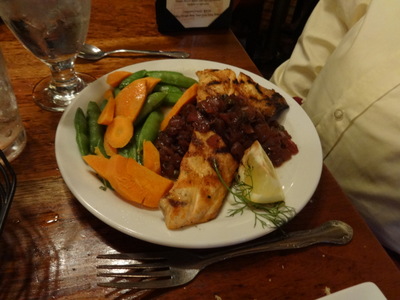
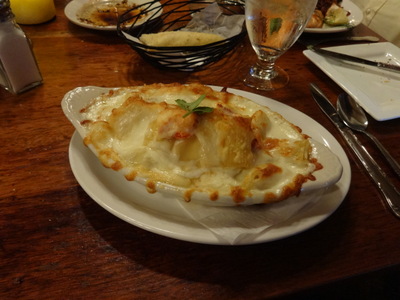 Jack chose the grilled salmon, topped with a sauce of caramelized red onions and capers and sided with sugar snaps and carrots. He pronounced it entirely satisfactory
Jack chose the grilled salmon, topped with a sauce of caramelized red onions and capers and sided with sugar snaps and carrots. He pronounced it entirely satisfactory
I went for the ziti baked with lobster, cream sauce, and cheese. As promised, it was thickly studded with chunks of lobster knuckle and claw meat embedded in a sauce that seemed to have a lot of ricotta in it, as well as all the mozzarella on top. Very good, but talk about rich!
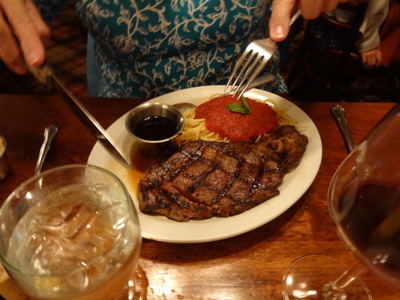
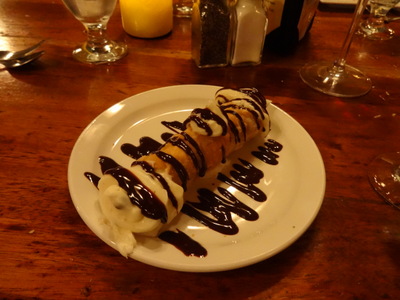 Jan ordered the smaller cut of prime rib, and at the right is what she got—a steak with prominent grill marks. It took a while to flag down the waiter and then a long delay before the roast beef appeared. It turned out to be overcooked, tough, and dry, although Jan said the side of spaghetti was excellent.
Jan ordered the smaller cut of prime rib, and at the right is what she got—a steak with prominent grill marks. It took a while to flag down the waiter and then a long delay before the roast beef appeared. It turned out to be overcooked, tough, and dry, although Jan said the side of spaghetti was excellent.
For dessert, David, Jack, and I all shared a very good cannoli.
Previous entry
List of Entries
next entry

 The animal of the day spotted out the window first thing was this bunny, larger than the one we'd seen before, sitting by the parked cars, placidly munching on scrubby little bushes that must have been covered with dust. At least he's getting his minerals.
The animal of the day spotted out the window first thing was this bunny, larger than the one we'd seen before, sitting by the parked cars, placidly munching on scrubby little bushes that must have been covered with dust. At least he's getting his minerals.
 Again, I'll start showing flower photos (I took a bazillion, but I present only the better shots here). Here are have cow parsley (or cow parsnip?) on the left and giant angelica on the right. The first has flat umbels and the second globular ones.
Again, I'll start showing flower photos (I took a bazillion, but I present only the better shots here). Here are have cow parsley (or cow parsnip?) on the left and giant angelica on the right. The first has flat umbels and the second globular ones.
 Here, on the left is what I'm pretty sure is the beardless penstemon, so the one I showed above must be the one-sided. At the right is a little blue flower than Susan couldn't come up with the name of, about the size of a penny and very low to the ground. She hypothesized blue-eyed Mary, but wasn't very unsure, and I don't think it was. I'm guessing flax (not really flax but what they call flax in the Rockies), but I'm not sure either.
Here, on the left is what I'm pretty sure is the beardless penstemon, so the one I showed above must be the one-sided. At the right is a little blue flower than Susan couldn't come up with the name of, about the size of a penny and very low to the ground. She hypothesized blue-eyed Mary, but wasn't very unsure, and I don't think it was. I'm guessing flax (not really flax but what they call flax in the Rockies), but I'm not sure either.




 At the left here is the low or bush sunflower, recognizable by its extremely rough, sandpapery leaves. At the right is a clump of cut-leaf primrose, a very pale Oenothera.
At the left here is the low or bush sunflower, recognizable by its extremely rough, sandpapery leaves. At the right is a clump of cut-leaf primrose, a very pale Oenothera.
 On the left here is a stalk of pinedrops, a root parasite of trees. It's in the Ericaceae, the blueberry family, but like most parasitic plants, it doesn't bother with photosynthesis and has reduced itself to the essentials (stem, flowers, fruiting bodies) and doesn't much look like it. We also saw a specimen of the other tree-root parasite in the area, an orchid called spotted coral root, but it was old, and the flowers were withered and brown.
On the left here is a stalk of pinedrops, a root parasite of trees. It's in the Ericaceae, the blueberry family, but like most parasitic plants, it doesn't bother with photosynthesis and has reduced itself to the essentials (stem, flowers, fruiting bodies) and doesn't much look like it. We also saw a specimen of the other tree-root parasite in the area, an orchid called spotted coral root, but it was old, and the flowers were withered and brown.
 For dinner, we went to the Dunraven, which is famous for its decor as well as its food. The front room is entirely papered in dollar bills signed by diners, and throughout it displays a large collection of variations on the Monda Lisa. At the left here is a segment of the dollar-covered wall and a two-panel protrayal of the Mona Lisa holding a jar of spaghetti sauce; the two panels are labeled "regular" and "chunky."
For dinner, we went to the Dunraven, which is famous for its decor as well as its food. The front room is entirely papered in dollar bills signed by diners, and throughout it displays a large collection of variations on the Monda Lisa. At the left here is a segment of the dollar-covered wall and a two-panel protrayal of the Mona Lisa holding a jar of spaghetti sauce; the two panels are labeled "regular" and "chunky."
 At the left here is the basket of soft breadsticks, coated with butter, parmesan, and garlic, to be torn up and dipped into the dish of oil and vinegar.
At the left here is the basket of soft breadsticks, coated with butter, parmesan, and garlic, to be torn up and dipped into the dish of oil and vinegar. 
 At the left here is the house salad, with Italian dressing. All the other usual choices were also available—ranch, blue cheese, etc.
At the left here is the house salad, with Italian dressing. All the other usual choices were also available—ranch, blue cheese, etc.
 Jack chose the grilled salmon, topped with a sauce of caramelized red onions and capers and sided with sugar snaps and carrots. He pronounced it entirely satisfactory
Jack chose the grilled salmon, topped with a sauce of caramelized red onions and capers and sided with sugar snaps and carrots. He pronounced it entirely satisfactory
 Jan ordered the smaller cut of prime rib, and at the right is what she got—a steak with prominent grill marks. It took a while to flag down the waiter and then a long delay before the roast beef appeared. It turned out to be overcooked, tough, and dry, although Jan said the side of spaghetti was excellent.
Jan ordered the smaller cut of prime rib, and at the right is what she got—a steak with prominent grill marks. It took a while to flag down the waiter and then a long delay before the roast beef appeared. It turned out to be overcooked, tough, and dry, although Jan said the side of spaghetti was excellent.